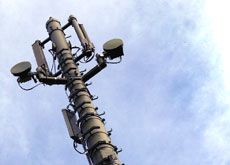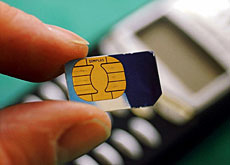Mobile phone antennae spark protests

Swiss mobile phone operators are racing to put up new masts in preparation for third generation (3G) mobile technology, which is due to be launched this autumn.
But they are facing stiff opposition from the public amid fears that the aerials are the source of electromagnetic pollution – which may damage health.
The antennae are a part of the Universal Mobile Telecommunications System (UMTS) network, the 3G industry standard being adopted by many mobile operators.
Hailed as the future for mobile phones, UMTS delivers much higher download speeds than the current system, making it easier for users to access the web and send images, music and video from their phones.
Swiss companies have been investing billions of francs in the new system. Over the past few years, the three main mobile service providers, Swisscom, Sunrise and Orange, have built more than 1,000 UMTS installations.
And a further 2,000 to 3,000 antennae are due to be erected in the coming months.
Unpopular
But concerns about the effects of “electrosmog” – electromagnetic radiation from antennae – have prompted a public outcry.
“Practically every new aerial is causing a protest – people have become very sensitive to the problem of electromagnetic pollution,” said Christian Neuhaus, spokesman for Swisscom.
Several recent scientific studies have pointed to a link between electromagnetic radiation and health, ranging from headaches and insomnia, to certain forms of cancer, such as leukaemia.
But the evidence is not conclusive and the government – which authorised the antennae – has therefore rejected all calls for a moratorium on UMTS.
This has not stopped a number of planning appeals being lodged by protesters, which despite being costly and often unsuccessful have been causing disruptions to the installation of the new system.
“The protests are causing delays and costing money,” said Bernhard Bürki, spokesman for the Federal Communications Office.
“It is now very unlikely that the three phone operators will be able to ensure 50 per cent UMTS coverage by the end of 2004, as the law requires,” he added.
Reassurance
Both the authorities and mobile phone operators have been trying to reassure the public by pointing out that levels of electromagnetic radiation are ten times lower in Switzerland than in many other European countries.
But Josef Peter, director of MPA Engineering, a firm which specialises in protecting people against electrosmog, says that the legislation is not as effective at it seems.
“Although our measures are some of the most restrictive, for technical reasons radiation levels are no higher in other countries,” he said.
Peter says the real problem is the location of antennae – sometimes put up in residential areas – rather than the intensity of their electromagnetic fields. He says companies should ensure that they install mobile antennae in more suitable locations.
Effects on humans
The expert – who has already investigated more than 1,200 cases, including one affecting a member of the Swiss government – is, however, convinced that non-ionised radiation affects humans.
“The greatest danger probably arises from the fact that the radiation is not continuous, the electrical signal is interrupted and re-established hundreds of times every second,” said Peter.
Peter advises people on how to protect themselves against electrosmog, but it is often an expensive process. A survey can cost up to SFr2,500 ($1,982) and the work up to SFr5,000.
Specialists also have to check for other sources of electromagnetic fields before carrying out their work.
“In 90 per cent of cases, health conditions are due to other factors – domestic appliances, computers, electrical wiring,” said Peter.
“But people only become aware of them when they are faced with the problem posed by antennae.”
swissinfo, Armando Mombelli
9,000 radio masts have already been built for the Global System for Mobile Communications (GSM) and General Packet Radio Service (GPRS) telecommunications systems.
There are plans to erect a further 4,000 aerials for the new UMTS system.
The three Swiss mobile telephone operators – Swisscom, Sunrise and Orange – are aiming to provide UMTS services by the autumn.
They are legally bound to provide coverage for 50% of the population by the end of 2004.
Public awareness of the problems associated with electromagnetic fields has increased in recent years.

In compliance with the JTI standards
More: SWI swissinfo.ch certified by the Journalism Trust Initiative


You can find an overview of ongoing debates with our journalists here. Please join us!
If you want to start a conversation about a topic raised in this article or want to report factual errors, email us at english@swissinfo.ch.